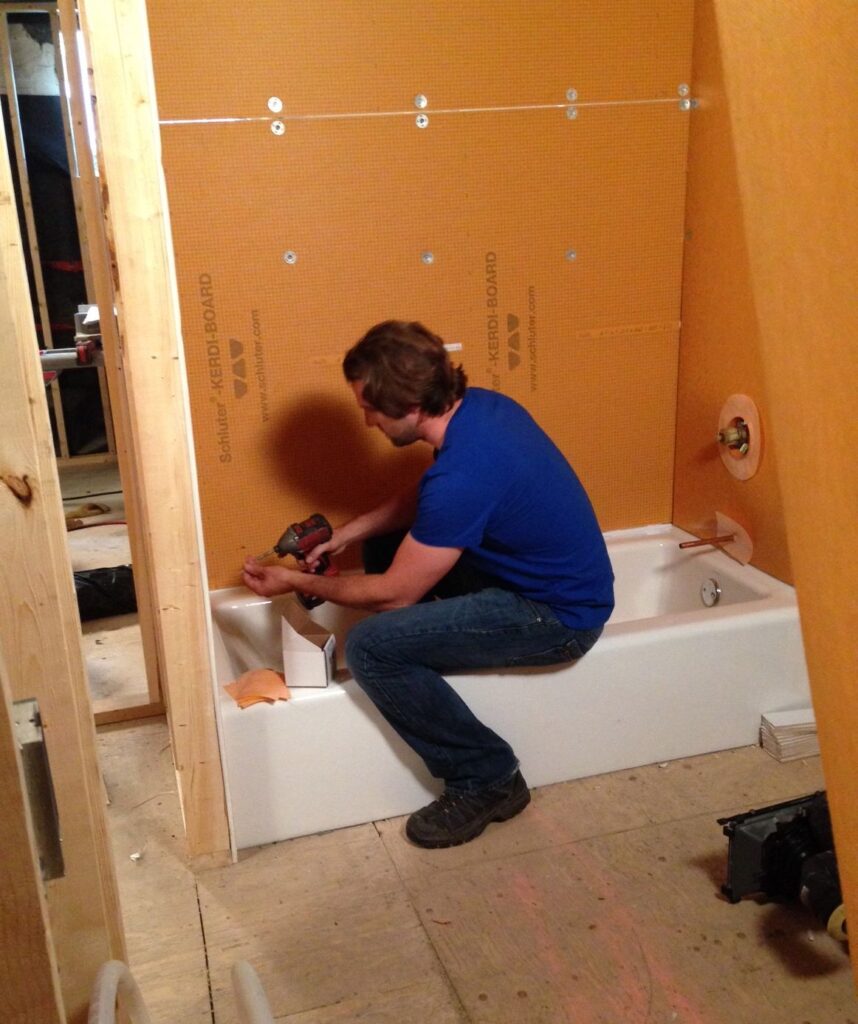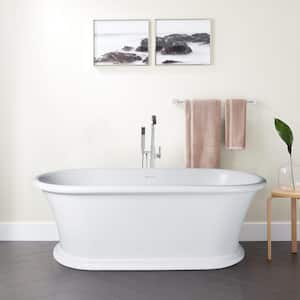Plumbing Essentials: A Prerequisite for When Installing a Bathtub
Plumbing Essentials: A Prerequisite for When Installing a Bathtub
Blog Article
What are your thoughts about Installing A Bathtub?

Setting up a bath tub isn't specifically rocket science, but it does require solid plumbing, carpentry, and in some cases, tiling skills. Replacing an old bathtub with a new one is additionally a reasonably difficult project. If the old bathtub is conveniently accessible, the project can relocate speedily; if you have to open a wall surface to remove the old bathtub as well as place the new bathtub, the task is a lot harder. In either situation, the job is within a home handyman's skills, although you will need a helper to move out the old tub and also embeded in the new one. Make sure you have qualified yourself for the work as well as are comfortable trying it. Rather than working with a service provider to take control of a halfway-completed project, it is far better to think about employing one prior to you begin. Possibilities are you may need a specialist plumber to make tube connections.
This post will assist you mount a brand-new bathtub in your shower room if you have already bought a new bathtub and also do not require to alter the plan of your previous water pipelines.
Your devices and also material checklist ought to comprise the following:
Removing Old Touches
If you require to replace old taps with new ones as a part of your installation, after that the first thing you must do is detach the water supply. After doing so, turn on the faucets to drain pipes any water continuing to be in the system. The procedure of removing the existing faucets can be rather bothersome because of the limited gain access to that is frequently the instance.
Make use of a container wrench (crowsfoot spanner) or a tap tool to reverse the nut that links the supply pipelines to the faucets. Have a cloth all set for the staying water that will come from the pipelines. When the supply pipelines have actually been removed, make use of the very same tool to loosen up the nut that holds the taps onto the bath/basin. You will certainly need to stop the solitary taps from turning throughout this process. As soon as the faucets have actually been eliminated, the holes in the bath/basin will certainly have to be cleaned up of any kind of old securing compound.
Prior to proceeding to fit the new faucets, compare the pipeline links on the old taps to the new faucets. If the old faucets are longer than the new taps, after that a shank adapter is needed for the brand-new faucets to fit.
Suitable New Taps
If the tails of the new taps are plastic, then you will certainly require a plastic adapter to prevent damage to the thread. One end of the port fits on the plastic tail of the faucet and also the other end provides a connection to the existent supply pipes.
If you need to fit a monobloc, then you will require minimizing couplers, which attaches the 10mm pipeline of the monobloc to the typical 15mm supply pipeline.
Next off, place the tap in the installing hole in the bath/basin guaranteeing that the washers are in place between the faucet as well as the sink. Protect the tap in position with the maker supplied backnut. Once the faucet is securely in position, the supply pipes can be connected to the tails of the faucets. The taps can either be attached by utilizing corrugated copper piping or with normal faucet connectors. The previous type ought to be connected to the faucet ends initially, tightening just by hand. The supply pipelines can later be attached to the other end. Tighten up both ends with a spanner after both ends have been attached.
Setting up the Tub
Using the two wooden boards under its feet, put the bathtub in the required setting. The wooden boards are practical in evenly spreading the weight of the bath tub over the location of the boards instead of focusing all the weight onto 4 tiny points.
The next goal is to make certain that the bathtub is leveled all round. This can be achieved by inspecting the spirit level as well as readjusting the feet on the bath tub till the level reads level.
To install taps, fit all-time low of the outermost versatile faucet port to the proper supply pipeline by making a compression join; then do the very same for the various other tap.
Turn on the supply of water as well as check all joints and new pipework for leakages as well as tighten them if needed. Fill the bathtub and also examine the overflow outlet and the regular electrical outlet for leakages.
Finally, fix the bathroom paneling as explained in the manufacturer's instruction manual. Tiling and also sealing around the tub needs to wait up until the bathtub has actually been used a minimum of when as this will resolve it into its last position.
Getting ready for the Installation
Firstly, the supporting frame provided with the bathroom ought to be fitted (if required) according to the manufacturer's instructions. Next off, fit the taps or mixer to the bathtub. When fitting the faucet block, it is necessary to see to it that if the faucet comes with a plastic washing machine, it is fitted in between the bathroom and the faucets. On a plastic bathroom, it is additionally sensible to fit a supporting plate under the taps system to prevent strain on the bathtub.
Fit the flexible tap connectors to the bottom of the two taps utilizing 2 nuts as well as olives (occasionally provided with the bathtub). Fit the plug-hole electrical outlet by smearing mastic filler round the sink electrical outlet opening, and after that pass the outlet through the hole in the bath. Use the nut supplied by the supplier to fit the plug-hole. Check out the plug-hole electrical outlet for an inlet on the side for the overflow pipe.
Next, fit the end of the adaptable overflow pipeline to the overflow outlet. Afterwards, screw the pipeline to the overflow face which ought to be fitted inside the bath. Make sure you make use of all of the provided washers.
Attach the catch to the bottom of the waste outlet on the bath tub by winding the thread of the waste electrical outlet with silicone mastic or PTFE tape, as well as screw on the trap to the electrical outlet. Connect all-time low of the overflow tube in a comparable manner.The bath need to now be ready to be suited its final setting.
Tiling Around the Bath tub
In the area where the bathroom fulfills the tile, it is needed to secure the joins with a silicone rubber caulking. This is very important as the installation can move enough to break a rigid seal, causing the water to permeate the wall surface in between the bathroom and also the tiling, causing issues with wetness and also feasible leaks to the ceiling below.
You can choose from a range of coloured sealants to blend in your components as well as installations. They are marketed in tubes and cartridges, and also can securing spaces as much as a width of 3mm (1/8 inch). If you have a larger gap to load, you can load it with twists of soaked paper or soft rope. Remember to constantly fill up the bath tub with water before securing, to allow for the motion experienced when the tub remains in use. The sealant can break fairly very early if you do not think about this motion before securing.
Alternatively, ceramic coving or quadrant ceramic tiles can be used to edge the bathroom or shower tray. Plastic strips of coving, which are easy to use and reduce to dimension, are also conveniently offered on the marketplace. It is recommended to fit the floor tiles making use of waterproof or water resistant glue and cement.
Bathtub Installation
How Important Is A Bathtub To Your Home?
High-quality baths, showers, and other bathroom updates are necessary when considering a smart investment in your home. It’s a room that you go to every day and one that is constantly being used by guests.The bathroom is one of the top trafficked rooms in a home and also one of the most valuable in terms of home resale.
Install Piping Before Tub
You will be using your existing drain and waste vent system, but pipes required include the hot and cold water supply lines and a pipe leading to a shower head. A mixing valve and shower head are also needed. Air chambers may be required.
Position the Tub
Lower the tub into place so that the continuous flange fits against the wall studs and rests on 1’x4' or 2’x4' supports. Anchor the tub to the enclosure with nails or screws inserted through the flanges into the studs.
NOTE: Remember, bathtubs and shower stalls may require support framing. A bathtub filled with water is extremely heavy, so check building codes and framing support before installing the tub.
Assemble Drain Connections
Assemble the bathtub drain connections by connecting the tub overflow with the tub drain above the trap, not beyond it. The trap will have a compression fitting that screws over the arm of the overflow assembly.
Place a Pipe For the Shower Head
First, locate a brass female threaded winged fitting and attach it to a framing support via a screw or a nail. Then run a pipe up the wall for the shower head. Sweat or solder the other side of the brass fitting to the top of the pipe.
Attaching Hot and Cold Water Lines
Attach your water lines for both hot and cold by sweating these directly into the hot and cold ports of the mixing valve. The mixing valve will be how water enters the tub’s system, not by the pipes themselves.
Install the Spout
Extend a piece of 1/2 inch pipe, or whichever length is specified in the manufacturer’s instructions, for the tub spout. Sweat on a male threaded fitting at the end of the pipe or use a brass nipple of the proper length and a 1/2 inch cap.
NOTE: At this point you should have your rough-in plumbing work inspected before proceeding further.
Check For Leaks
Restore the water pressure and check the drain connection and the supply pipes for any sign of leaking.
estore the Bathroom Wall
Replace the wall with moisture-resistant drywall as a base for your wall covering. Seal the joints between the wall and your new tub with silicone caulk as protection against water seepage.
https://www.berkeys.com/2016/12/02/bathtub-installation-dallas/

As a devoted reader on A Step-by-Step Guide to Installing a Bathtub, I thought sharing that piece of content was sensible. Sharing is good. Helping others is fun. Bless you for your time. Don't forget to come by our site back soon.
Today's problem, today's fix! Report this page